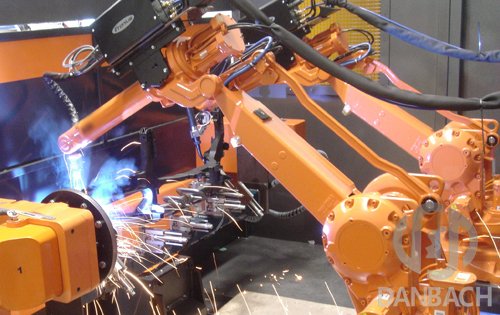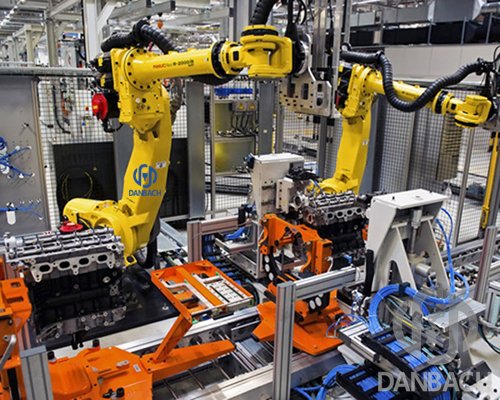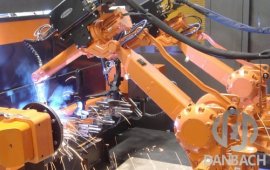There are a variety of definitions of the term robot. Depending on the definition used, the number of robot installations worldwide varies widely. Numerous single-purpose machines are used in manufacturing plants that might appear to be robots. These machines are hardwired to perform a single function and can’t be reprogrammed to perform a different function. Such single-purpose machines do not fit the definition for industrial robots that is becoming widely accepted. This definition was developed by the Robot Institute of America:
A robot is a reprogrammable multifunctional manipulator designed to move material, parts, tools, or specialized devices through variable programmed motions for the performance of a variety of tasks.

Note that this definition contains two words reprogrammable and multifunctional. It is these two characteristics that separate the true industrial robot from the various single-purpose machines used in modem manufacturing firms. The term reprogrammable implies two things: The robot operates according to written program, and this program can be rewritten to accommodate a variety of manufacturing tasks.
The term “multifunctional”means that the robot can, through reprogramming and the use of different end-effectors, perform a number of different manufacturing tasks. Definitions written around these two critical characteristics are becoming the accepted definitions among manufacturing professionals.The first articulated arm came about in 1951 and was used by the U.S. Atomic Energy Commissions in 1954 , the first programmable robot was designed by George Devol.
It was based on two important technologies: (1)Numerical control (NC)technology (2)Remote manipulator technology Numerical control technology provided a form of machine control ideally suited to robots. It allowed for the control of motion by stored programs, these programs contain data points to which the robot sequentially moves , timing singals to initiate action and to stop movement, and logic statement so allow for decision-marking. Remote manipulator technology allowed a machine to be more than just another NC machine. It allowed such machines to become robots that can perform a variety of manufacturing tasks in both inaccessible and unsafe environments.
By merging these two technologies, Devol developed the first industrial robot, an unsophisticated programmable materials handing machine. The first commercially produced robot was developed in 1959. In 1962 , the first industrial robot to be used on a production line was installed by General Motors Corporation. This robot was produced by Unimation, A major step forward in robot control occurred in 1973 with the development of the T-3 industrial robot by Cincinnlti mihcrcon. The T-3 robot was the first commercially produced Industrial robot controlled by a minicomputer.
Numerical control and remote manipulator technology program the wide-scale development and use of industrial robots, but major technological developments do not take place simply because of such new capabilities. Something must provide the impetus for taking advantage of these capabilities. In the case of industrial robots, the impetus was economics. The rapid inflation of wages experienced in the 1970s, tremendously increased the personnel costs of manufacturing firms. At the same time, foreign competition became a serious problem for U.S. manufacturers. Foreign manufacturers who had undertaken automation on a wide-scale basis, such as those in Japan, began to gain an increasingly large share of U.S. and world market for manufactured goods, particularly automobiles.

Through a variety of automation techniques, including robots, Japanese manufacturers, beginning in the 1970s, were able to produce better automobiles more cheaply than non-automated U.S. manufacturers. Consequently, in order to survive, U.S. manufacturers were forced to consider any technological developments that could help improve productivity. It became imperative to produce better products at lower costs in order to be competitive with foreign manufacturers. Other factors such as the need to find better ways of performing dangerous manufacturing tasks contributed to the development of industrial robots. However,the principal rationale has always been, and is still, improved productivity. One of the principal advantages of robot is that they can be used in settings that are dangerous to humans, Welding and parting are examples of applications where robots can be used more safely than humans. Even though robots are closely associated with safety in the workplace, they can, in themselves, be dangerous.
Robots and robot cells must be carefully designed and configured so that they do not endanger human workers and other machines. Robot work envelops should be accurately calculated and a danger zone surrounding the envelope clearly marked off.
Red flooring strips and barriers can be used to keep human workers out of a robot’s work envelop. Even with such precautions it is still a good idea to have an automatic shutdown system in situations where robots are used. Such a system should have the capacity to sense the need for an automatic shutdown of operation, fault-tolerant computer and redundant systems can be installed to ensure proper shutdown of robotics systems to ensure a safe environment.
 中文
中文 English
English

